Lea Wait's Blog, page 51
September 11, 2023
More Than A Shoe Part

… Well, this could be the last time
This could be the last time
Maybe the last time
I don’t know, oh no, oh no (Rolling Stones)
John Clark musing about the concept of When. After my third fall on the day before Labor Day (only my ego suffered), the most abysmal gardening year of my life, and assorted dark thoughts (non-lethal, but mostly humorous as hell), I’ve turned to pondering those ‘last times’ all of us will face, or maybe already have started to.
Some are part of the natural evolution of life. There was a time when I bowled ten pins three nights a week, but that lost its allure a long time ago. I still have uncounted gigabytes of computer role-playing games on my two computers, but while I think of them fondly, I hardly ever play, mostly because it’s more fun to create my own fantasy lands as a writer. The same goes for friends. I learned a long time ago that not everyone ages or matures at the same rate and I’ve outgrown people I was once very close to.
Then, there are ‘lasts’ beyond our control…places going out of business like the movie theater in Pittsfield and the drive-in in Skowhegan, or products we’ve bought and come to rely upon that have vanished from store shelves.
In my case, it seems like every birthday after a certain point that ends in zero changes my body chemistry to make eating something I’ve enjoyed all my life unpleasant. at fifty it was fried foods, at sixty spicy stuff (at least the upper ranges I used to consume with impunity). ant at seventy, I discovered I had a sudden intolerance for avocadoes.
I have a friend and a cousin who have sold their motorcycles because of the danger of dropping them, or getting hit while driving. Likewise two other friends have sold their boats and no longer fish. They cited the following reasons, danger of tipping and lack of fishing buddies. In a related scenario, a friend in Hartland volunteered that he’d quit hunting when he had to use his shotgun to help prop him up so he could walk home.

Most of the ‘lasts’ that come to mind involve physical activity, but not all. Consider the following: going to a concert-rude, rowdy crowds and poor hearing all come to mind as does the sad reality that many of the performers we grew up with are dropping like flies (I really miss Gordon Lightfoot), not to mention obscene ticket prices. Twenty-two years ago today (9/11) probably did it for many in terms of flying. We still do, but given a choice, I’d go by train. Then, there are pets. We have an old, nearly blind and deaf dog who we both love, but when he’s gone, that’s likely it. I’m tired of feeling like I’m a hostage to his weak bladder.
As for the physical stuff. I know climbing even a gentle mountain trail is behind me. We climbed Katahdin 47 years ago and I can still remember how long it took to stand up without wincing after we returned to camp. Flat, well-cleared trails are still doable, but wading on slippery rocks while fishing is out, as is getting into a kayak. The getting in is no problem, the reverse, however is likely a deal breaker. Canoeing is still possible as long as the two of us can get the sucker atop my car and fasten it securely.
As for gardening, given how much money we put into ours this year, not to mention the time and effort (mostly on Beth’s part) to keep it weeded, just so we could get a handful of tomatoes, celery, and a few meals of beans? Not likely to go there again.
‘Whens’ still on the go list include going to sporting events, eating out, plays, day trips, taking unusual photos, our week in Perry, going to book sales and then selling online (that NEVER gets old), discovering new books to read (don’t tell Beth, but I have 6 new ones on order at Bullmoose), cloud watching, and most important of all, coming up with new story ideas whether they are short ones or book length. I sat down last week to create something for a short story competition sponsored by a liquor company. The requirements were a it needed a ghost and had to be between 250-2000 words. I whipped up a nice rough draft of 1945 words in three hours. Once it set for a couple days, I submitted it. Will it win? No way of telling, but the last one I wrote for a similar contest ended up in King’s River Life.

Where are you on the ‘last’ spectrum?
September 8, 2023
Weekend Update: September 9-10, 2023
 Next week at Maine Crime Writers there will be a posts by John Clark (Monday), Maggie Robinson (Tuesday), Kaitlyn Dunnett/Kathy Lynn Emerson (Thursday), and Kate Flora (Friday).
Next week at Maine Crime Writers there will be a posts by John Clark (Monday), Maggie Robinson (Tuesday), Kaitlyn Dunnett/Kathy Lynn Emerson (Thursday), and Kate Flora (Friday).
In the news department, here’s what’s happening with some of us who blog regularly at Maine Crime Writers:
from Kaitkyn Dunnett/Kathy Lynn Emerson: I have another omnibus edition out, this one consisting of three romance novels previously published by Bantam’s Loveswept line in the late 1990s.
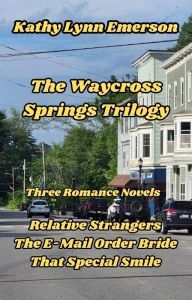
The Waycross Springs Trilogy features three stories set in Waycross Springs, Maine, a location that also appears in some of the Liss MacCrimmon mysteries and in The Valentine Veilleiux Mysteries. For more information, please go to http://www.kathylynnemerson.com/romance.htm Several familiar faces from Liss MacCrimmon’s world also turn up in these novels. Although it is available at all the usual online bookstores, here’s the Amazon link for convenience:
Our friends at the Topsham Library have asked us to share information about their annual writing competition. Check it out here:
Don’t forget our body contest. Time is running out and entries are rolling in. Will we have one from you?
It’s Maine Crime Writers “Where Would You Put the Body?” contest – late summer/early fall edition. How do you enter? Send a photograph of your chosen spot to: WritingAboutCrime@gmail.com with “Where Would You Put the Body?” in the subject line. There will be prizes for First, Second, and Third place–books of course and other Maine goodies. You may enter no more than three photographs, each one entered separately. They must be of Maine places and you must identify the place in your submission. Photos must be the submitter’s original work. Contest will run through the middle of October.
An invitation to readers of this blog: Do you have news relating to Maine, Crime, or Writing? We’d love to hear from you. Just comment below to share.
And a reminder: If your library, school, or organization is looking for a speaker, we are often available to talk about the writing process, research, where we get our ideas, and other mysteries of the business, along with the very popular “Making a Mystery” with audience participation, and “Casting Call: How We Staff Our Mysteries.” We also do programs on Zoom. Contact Kate Flora
Publication Groundhog Day
Marketing. Book selling. NetGalley. BookSirens. Double down on Twitter. No, it’s called X now. Send out ARCs to readers. Book bloggers. Book tour bloggers. Tell people about my new novel. Tell more people. Spread the news on Facebook without totally annoying people and making them hate me. Create marketing visuals (actually beg my son to make them).
Oh, did I tell you I have a new book coming out on October 24th? That’s why all this marketing hubbub. All the publicity and worry lines, wrinkles and anxiety.
The name of my new novel is The Anchorman’s Wife and I’m already freaking out.
Ask writers for blurbs. Got ‘em. Thank the people who wrote great blurbs and penned advance book reviews. Convince myself I’m not a fraud and imposter but a real writer. Go to the post office and send out ARCs of this wonderful new book I’m sick of editing. Tell the postal office clerk that there are books inside the Manila envelope while fighting the urge to tell same clerk that they are my books. The books I wrote. That I’m a not-so-famous author. Then I jokingly tell the clerk that I’m a novelist and I’m sending out books, hoping he’ll be impressed, but he grimaces and asks me for $19.80. Oh, and if I want stamps.
Return home. Schedule podcast appearances. Call bookstores to make sure they carry my book. Read existing reviews of my novel and realize there are some errors and inconsistencies that made it through to the ARC. Damn. Make notes to fix dumb errors before they appear in the final version. Keep track of email addresses to put into my mailing list—which I have yet to set up.
Sit down. Take a deep breath. Try to ignore the intense pain in my chest. Tell myself not to have an anxiety attack over the first world problem of being an author. Try not to worry about the bad reviews that will come with publishing this novel (there are always bad reviews) and bad sales (there are always bad sales). Call my therapist and set up another session. Take anti anxiety meds. Knock back shots of Pepto Bismo. Grab a box of tissues in the event I feel a tear coming on.
Shit! I forgot about the blog post I have to write by mid morning. For the Maine Crime Writers blog! That damn Kate Flora never stops reminding me of my blog responsibilities, although I loved her last novel. Stop thinking about marketing my book and think about what I’m going to write about in blog. Sip coffee and consider various topics, but dismiss each and every one. Procrastinate. Go into the kitchen and stare into the near empty fridge for the nth time. Grab a celery stalk and head back to the desk to write my blog. Hopefully, whoever reads this won’t think I’m a complete moron.
Check the reviews on NetGalley and realize that my best review has been taken down by the reviewer who wrote it. Curse! Jump up and down. Punch the wall. Tear out the three remaining hairs on my head. Spend the next three hours trying to track down this reviewer and demand to know why she has taken down such a such a superfluous review. Did I offend her? Did she go back and realize that she hated my book? Just my luck. Grab a tissue and have a good cry.
Feeling better now. Until I glance at the preorders on Amazon. Have another quick crying spell. See that it’s near bedtime and hit the hay. Have nightmares about publishing this new novel. Wake up several times in a cold sweat.
Wake up in the morning. Get my coffee.
It’s a new day in Publishkistan.
Do the above all over again. Except write blog.
Until the day of reckoning on October 24th when The Anchorman’s Wife finally publishes.

September 7, 2023
Beware the psych pit of getting near publication
by Jule Selbo
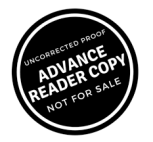
A few days ago, my publisher sent me a note and a file: “Here is the latest draft – the result of your reactions/addressing of the editor’s notes. You now have one more look-through before the ARC is finalized. Please proceed in a timely manner.”
Some writers – thinking that the publication date is coming soon-ish – might be jumping for joy!
Not me.
I take the day off. And the next day. And maybe even the next day too.
Because I feel threatened. I feel ‘command’ and the ‘demand’ in the air and that causes, in me, a fear that the “process” has put someone else in charge.

Does that happen to other writers?
I feel resentful and pressured. And, yes – threatened. It’s all I can do to not send a bitchy response – something like “this is ‘my book’ and please don’t take away my complete ownership of it.”
I know. I know. It’s about control. Only weeks ago, I could decide to rewrite the same page twenty times if I wasn’t happy with it. I could change a character’s name if I suddenly came up with a better one. I could adjust the pacing. I could add a bit here, trim a bit there. Add weather to accelerate tension. Or let a character breathe a bit and dig into her whys and wherefores and mindset.
This “just before the ARC” step is more stressful than starting the process with my editor. (I will refer to this editor as “K” here to protect the innocent.)
K doesn’t like run-on sentences. For fun, when we first started working together, I sent K things like Hemingway’s longest sentence (from his safari/hunting book Green Hills of Africa):

“That something I cannot yet define completely but the feeling comes when you write well and truly of something and know impersonally you have written in that way and those who are paid to read it and report on it do not like the subject so they say it is all a fake, yet you know its value absolutely; or when you do something which people do not consider a serious occupation and yet you know truly, that it is as important and has always been as important as all the things that are in fashion, and when, on the sea, you are alone with it and know that this Gulf Stream you are living with, knowing, learning about, and loving, has moved, as it moves, since before man, and that it has gone by the shoreline of that long, beautiful, unhappy island since before Columbus sighted it and that the things you find out about it, and those that have always lived in it are permanent and of value because that stream will flow, as it has flowed, after the Indians, after the Spaniards, after the British, after the Americans and after all the Cubans and all the systems of governments, the richness, the poverty, the martyrdom, the sacrifice and the venality and the cruelty are all gone as the high-piled scow of garbage, bright-colored, white-flecked, ill-smelling, now tilted on its side, spills off its load into the blue water, turning it a pale green to a depth of four or five fathoms as the load spreads across the surface, the sinkable part going down and the flotsam of palm fronds, corks, bottles, and used electric light globes, seasoned with an occasional condom or a deep floating corset, the torn leaves of a student’s exercise book, a well-inflated dog, the occasional rat, the no-longer-distinguished cat; all this well shepherded by the boats of the garbage pickers who pluck their prizes with long poles, as interested, as intelligent, and as accurate as historians; they have the viewpoint; the stream, with no visible flow, takes five loads of this a day when things are going well in La Habana and in ten miles along the coast it is as clear and blue and unimpressed as it was ever before the tug hauled out the scow; and the palm fronds of our victories, the worn light bulbs of our discoveries and the empty condoms of our great loves float with no significance against one single, lasting thing—the stream.”
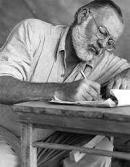
If you don’t feel like counting, there are 424 words, 42 commas, 5 semi-colons and one period in that sentence.
(The two pictures of Hemingway – imagine him starting the sentence and finally finishing it…)
I’m not fond of run-on sentences in general (preferring to read and write the shorter ones) but once in a while a good run-on can fit perfectly. In my opinion. But – by the time I got this “last chance to read before the ARC is finalized” alert, K and I had come to an agreement on the length of all my sentences so those had been taken care of.
K continues to worry I might use too many em dashes.

8 DAYS is the third book in the Dee Rommel series, and when working with K on 10 DAYS (the first of the series) I had to learn about em dashes. They had never really come up in my screenwriting work (my previous profession) or – for some reason in the three historical novels I’d written. So I started to think that it’s the tone/style I “adopted” for the crime/mystery series and for my main character’s style of reasoning and being.
Anyway, the em dash, I learned, is the “longest of the dashes – roughly the length of the letter m”. According to Kate Mooney in an article she wrote for The Independent, US edition, August 2019: “The em dash is emphatic, agile and still largely undefined. Sometimes it indicates an afterthought. Other times, it’s a fist pump. You might call it the bad boy, or cool girl, of punctuation. A freewheeling scofflaw. A rebel without a clause.”
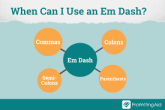
Sounds sort of wonderful, I thought. “For some writers,” Mooney continued, “the em dash is a vice that their editors occasionally forgive but more often forbid. It has been duly cast as an alluring alternative to the comma, colon, semicolon, and full stop in the “distracted boyfriend” meme.”


Editor K had me look at all my dash choices – the hyphen, the em and en dashes (the en being width of the letter n and it’s use pretty clear). Of course, I already understood the use of the hyphen because I’d been taught by strict nuns in elementary school.
So I concentrated on em dash research and found the below:
“This little symbol is beloved by writers everywhere and hated by many editors. It’s the most dramatic of all punctuation marks — literally its most common usage is to signify an abrupt change in the sentence or a pregnant pause, according to the AP Stylebook.”
“The em dash is a visually persuasive framing device ; the em dash helps the writer select a dominant meaning for the sentence while deflecting other meanings that are available.”
“(Em dash) is used in place of a comma, colon or semicolon for greater emphasis . It denotes a major break or pause and should not be overused.”
“In fiction, as in other kinds of writing, you’ll still want to use the em dash to indicate interruptions , performing a function related to — but subtly different from — parentheses. (The em dash is particularly useful in dialogue.)”
The tidbits on the em dash were interesting – but to me – not entirely helpful because some of the definitions and/or advice made me think more of “style” than “rule.”

Adam O’Fallon Price, in The Millions Literary Magazine wrote: (It) might be useful to include an official definition from the Punctuation Guide: “The em dash is perhaps the most versatile punctuation mark. Depending on the context, the em dash can take the place of commas, parentheses, or colons—in each case to slightly different effect.”
Price liked that “slightly different” appeal of the em dash. He wrote: “It is the doppelgänger of the punctuation world, a talented mimic impersonating other punctuation, but not exactly, leaving space to shade meaning. (It) can be especially revealing of an author’s style, even their character… (and can be) useful for both narrowing and expanding a train of thought that might lose momentum in a new sentence—in this sense, they also stand in for the semicolon, but semicolons are best used (in my fuddled cosmology of punctuation) as dividing walls between two related but independent thoughts of approximate equal value (I wholly reject, by the way, that old bullshit about eliminating semicolons).

Noreen Malone (not a fan of the em dash) wrote an article for Slate Magazine: “The Case -Please Hear Me Out – Against the Em Dash”: She subtitled it: Modern Prose doesn’t need any more interruptions – seriously.” In the article she laments: “The problem with the dash – as you have noticed! -is that it discourages truly efficient writing. It also – and this might be its worst sin – disrupts the flow of a sentence.”
Clearly, by using the em dashes, she made her point. She also observed: “America’s finest prose – in blogs, magazines, newspapers, or novels – is littered with so many dashes among the dots it’s as if the language is signaling distress in Morse Code.”
Again, Price and Malone seem to have opinions about the em dash. And perhaps druthers. But no “rule” emerges.
But, to make my editor K a little happy (my editor knows more about grammar than me for sure), I did change and/or delete some of my em dashes. This resulted, sometimes, in a longer sentence becoming two shorter sentences. Or if I added an ‘and’ as a connector (instead of the em dash) I could see where the read became less disjunctive. Sometimes I wrote in “my response to editor notes” that I’d prefer to leave it as is – and that was usually okay with K.
I know that 90% or so of typos (never all, is it, no matter how much we hope) will have been addressed in the ARC. And that once the ARC is ready, my publisher allows me to go through the manuscript one last time to try to catch any glaring (or not-glaring) fix-ables.
So, there’s still some time after this “ready for ARC” moment.
But still, anxiety roars when I get that email letting me know they expect my response “in a timely manner.”
As I wrote at the top of this essay, I know it’s about control. It’s about knowing that I’ve stepped through the pearly gate that can block publication and I’m on the other side. Whew.

But still, I get stuck on the idea that I have not stepped past St. Peter into a fluffy-cloud, everything’s-peachy-heaven. No. Beyond this pearly gate are lounging angels, archangels, gods, saints, do-gooders (or at least those who have done no harm) who are all voracious, avid readers – who may take good hard looks at my em dashes.
September 4, 2023
Summer, then Fall
The precipitous leap from summer to fall always takes me by surprise, never more than this year, when truly summery days were so precious.
The time we spent in Brooklin in late July and early August turned out to be the choicest two weeks of the summer, if sunshine is the measure. On Labor Day weekend we returned to the tiny rented cottage on the shore of Allen Cove, from where I’m writing this post.

The little red cottage on the shore
Once again, we brought our luck along. We’ve had three stellar days so far, but the signs of seasonal change are everywhere.
Take swimming. The ocean water was warmer this summer than we’ve ever known it to be, but this weekend, its characteristic chill was back. It didn’t stop us from swimming every day, but our dips didn’t last quite as long, and our skin tingled for a full ten minutes when we got out.

Our swims are briefer now, especially out at the Point
Another of our summer vacation rituals is to lounge in the Adirondack rockers on the cottage’s lawn, bathed in the ethereal golden hour glow while we await an 8 p.m. sunset. From our catbird seats it’s a straight shot up the cove to the spot where the summer sun slips out of sight, and its departure paints a broad streak across the sky that lasts another three quarters of an hour.

Summer sunset
Now, a mere four weeks later, the sun is much farther west when it drops below the treetops, making for more muted sunsets. The big moment happens a few minutes after 7:00 now, and it’s full dark by 7:40. This weekend we zipped into fleece jackets and wore socks rather than sandals while bearing witness not just to day’s end, but also to summer’s end.

September sunset
The air smells different, too. Drier, cleaner, saltier, as fall’s cycle of decomposition begins. The sumac are reddening, but the hydrangea varieties that start out white and turn brilliant pink are still in full flower, a consolation of sorts.
The terns who entertained us a month ago with their swift, precise dives into the cove have relocated. Here’s a video, for those who haven’t witnessed their particular dance: https://www.youtube.com/watch?v=hW83b0WAk8k
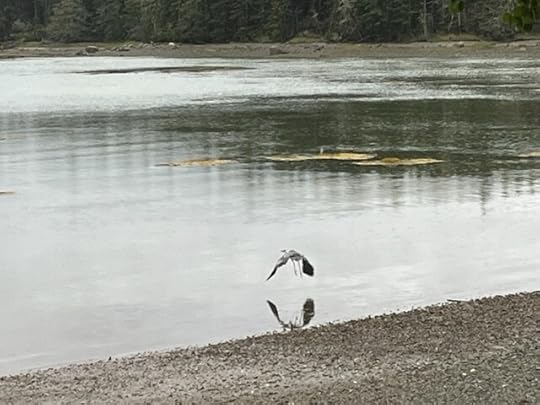
Blue Heron casing the Cove
We’ve seen only one blue heron so far, when in summer a trio swept low across the water at dusk, searching for a last snack. Is the juvenile now out exploring the big world, like kids heading off to school or college?
As for the songbirds, they’ve either departed or are quietly busy. The woods behind the cottage no longer ring with the echoing trill of the hermit thrush who serenades us in high summer, just like this: https://www.youtube.com/watch?v=hW83b0WAk8k
Also among the missing are the red-eyed vireo, the golden-crowned kinglet and the multitude of song sparrows. Perhaps they’ve migrated already, maybe they simply no longer need to sing out their needs (for love, for preferred territory) now that the season is turning.
I hope they’ve found both.
Brenda Buchanan brings years of experience as a journalist and a lawyer to her crime fiction. She has published three books featuring Joe Gale, a newspaper reporter who covers the crime and courts beat. She is now hard at work on new projects. FMI, go to http://brendabuchananwrites.com
A Crime Writer’s Uneasy Relationship with Guns
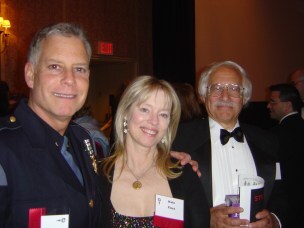
At the Edgars banquet with Joe Loughlin and my husband, Ken Cohen
Kate Flora: Sometimes, between books, between spurts of research, or after readingabout yet another awful shooting, I think about the difference between the world of today, where guns are rampant and used so carelessly and violently, and the world I grew up in, where guns were part of the culture but it was a culture that understood training and responsibility.
Back in my day, the NRA was all about gun safety and training. Boys like my brother John took NRA safety courses and got certificates. There were guns in our house but they were used for hunting. Hunting was a recreational activity—think armed forest bathing—but it was also essential for our financial survival. Getting a deer meant we’d have meat through the winter that we didn’t have to buy, a huge benefit for our tight budget. A lot of people, mostly men, carried .22s in their trucks that were useful for shooting the woodchucks that could decimate a garden a family depended on in a single night. Many of the men in my parents’ generation had fought in the war, where guns had been essential.

Deep in the Canadian woods, viewing the sentinel tree that the used to mark the location of Maria Tanasichuk’s body.
All of which is to say that I grew up comfortable with the idea that people had guns in their houses and fairly certain that in most cases, the people who owned those guns respected their dangerousness and used them responsibly. I think this is different from the way most people I know grew up.
Then I moved on. Moved away. Became surrounded by people for whom the idea of a gun I the house was shocking, not normal.
The world also changed. People’s relationship to guns changed. My assumption that people with guns were responsible people no longer matches the way guns are regulated, sold, and used today. So my country girl’s understanding of guns has changed, too. I absolutely believe in banning assault rifles. I believe in serious background checks for gun sales whether by a dealer or an individual. I believe that red flag laws are essential. I believe that all gun owners should be licensed just like drivers, that a license should be required to purchase ammunition, that gun locks and safe storage should be mandatory, and that owners should have to carry insurance against the dangers gun present. None of these things would have been a consideration back when I was growing up.
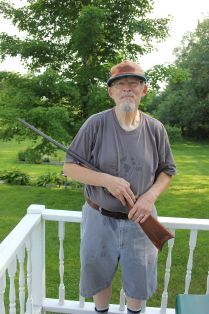
Brother John with his .22 pump-action. Mailboxes are safe, woodchucks not so safe.
Unlike my brother, I didn’t use the guns when I was growing up, but writing about crime and cops means I’ve had to have some exposure to guns in order to make my characters and situations credible. At one memorable conference in Florida, they bussed us out to a shooting range where we able to shoot a variety of weapons, then had a barbecue. Ear protectors, safety glasses, and an instructor at our elbows. I definitely learned firsthand that it wasn’t like on TV. It was loud and scary and the kickback was surprising. After that, and a few other episodes trying to be brave about guns, I know enough to leave that to the experts. But those episodes gave me a different, and vivid, insight into the situations I put my characters in.
Before I started writing with cops, “tunnel vision” was just an expression. It became a reality when I worked on Shots Fired: the misunderstandings, misconceptions, and myths about police shootings with Assistant Chief Joseph K. Loughlin. In story after story, the police officers interviewed for the book described what it was like to be in active shooting events. It was stunning, and surprising, to go inside their heads, relive those events, and then realize that they often took place in seconds. On TV, the characters may walk away unscathed. In the real world, being in a gun fight can have lasting impacts.
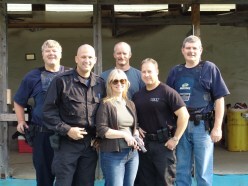
Sometimes research takes me in some strange directions, like to the shooting range.
Another situation that gave me insight into the world of guns and gun owners was working with retired Maine game warden Roger Guay on his memoir, A Good Man with a Dog: A Retired Game Warden’s 25 years in the Maine woods. Roger’s stories made me see his area of public safety in an entirely new way. Police officers may sometimes encounter people carrying guns; in the woods, far more of the people wardens encounter are. One of my favorite stories is that when I first went out driving with Roger so he could show me the territory he’d patrolled and start telling stories, his wife Jolyne got in the back seat with a shotgun. Not the usual way a writer researches a book. As she explained, it was bird season, so from time to time we’d stop and she’d shoot. I came away from the book with an amazed sense of how it is for public safety personnel to face down guns on a regular basis.
These writing relationships have given me experts I can turn to when I have questions

Maine wardens and volunteers with their cadaver dogs celebrating after finding Maria
about guns. And questions about guns come up often. I can send one of my emails with “Author Needs Help” in the subject line, describe the situation in my book, and ask what kind of gun the shooter might be using and what the aftermath might be like. While the world of uncontrolled gun ownership makes me nervous, I am grateful that I have these people, the responsible people, in my life.
I was given a gun once. It was a cute little pearl handled pocket gun. But I didn’t want a gun in the house, so I gave it back. There are times, these days, when the world seems so uncertain and so unsafe I wish I had it. But I don’t think the solution to our angry and unsettled world is for all us to be armed. I hope I’m right.
September 1, 2023
Weekend Update: September 2, 2023
 Next week at Maine Crime Writers there will be a posts by Kate Flora (Monday), Brenda Buchanan (Tuesday), Jule Selbo (Thursday), and Joe Souza (Friday).
Next week at Maine Crime Writers there will be a posts by Kate Flora (Monday), Brenda Buchanan (Tuesday), Jule Selbo (Thursday), and Joe Souza (Friday).
In the news department, here’s what’s happening with some of us who blog regularly at Maine Crime Writers:
An invitation to readers of this blog: Do you have news relating to Maine, Crime, or Writing? We’d love to hear from you. Just comment below to share.
And a reminder: If your library, school, or organization is looking for a speaker, we are often available to talk about the writing process, research, where we get our ideas, and other mysteries of the business, along with the very popular “Making a Mystery” with audience participation, and “Casting Call: How We Staff Our Mysteries.” We also do programs on Zoom. Contact Kate Flora
August 31, 2023
The Mystery of Aunt Carrie’s Boardinghouse
Kaitlyn Dunnett/Kathy Lynn Emerson here, today sharing another of my family history mysteries. Warning: this is a long post!
Recently, the land that went out of my mother’s family back in 1958 and was thereafter abandoned until it became completely overgrown, was sold to a gentleman who contacted me after seeing the page I have about that site on my webpage. It turned out that he not only bought what was the original Hornbeck farm on Whittaker Road in Hurleyville, New York, but also the property next door, the one that was a bungalow colony back in the 1950s. Among other questions, he asked if I could solve a mystery for him: why doesn’t the large pond on the Hornbeck lot show up on old maps of the area?
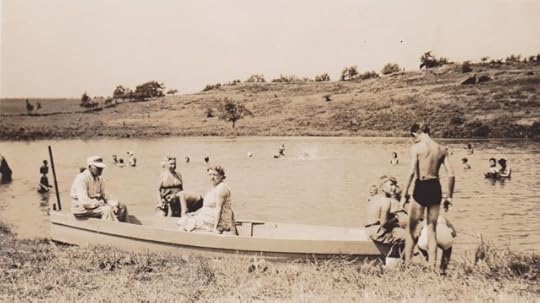
the farm pond in its heyday
That was easy to answer. My great-uncles, M.H. and Howard Hornbeck, dug the pond, probably sometime in the very early twentieth century, tapping into a spring to create a recreational feature for guests at the family’s summer boardinghouse. This was no small undertaking, but it proved quite successful. Swimming, boating, and fishing were a real draw in those early days of tourism in the foothills of the Catskills, and in the winter the uncles operated an ice harvesting business.

the same pond in 2023
As things turned out, the new owner ended up solving a mystery for me, too. A while back I came across a probate notice in the Sullivan County Record for May 20, 1897:
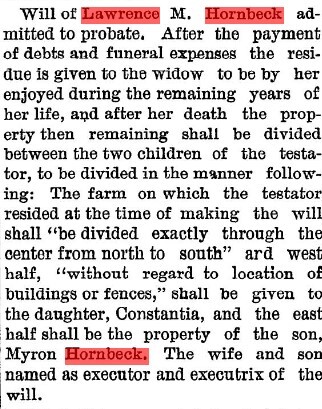
This puzzled me for a couple of reasons. For one thing, it was obvious that Lawrence made his will much earlier than 1897. At the time of his death, earlier that May at the age of 86, his son was married and had six children, his daughter was married and had two children, and his wife, the executrix, had been dead since 1890. None of their surviving descendants, at least the ones I’m in touch with, could ever remember hearing about the property being split in two and I wasn’t having any luck digging up any more information on Ancestry.com or in old newspapers. I did know, however, that Lawrence Hornbeck’s father had brought his family to Hurleyville from Rochester (now Accord) in Ulster County by 1850, and that Lawrence had married Catherine E. Gardner in 1856.
In 1860, in the non-population census taken of farms, Lawrence had 38 improved acres and 45 unimproved, valued at $1000. He had one horse, four cows, two oxen, three other cattle, six sheep, and one swine, valued at $200. In the previous year the farm had produced fifty bushels of rye and fifty bushels of oats. In the 1870 census his real estate was valued at $1600 and his personal estate at $1000. The 1870 non-population schedule listed his holdings as fifty improved acres and twenty-five of woodland. His farm implements and machinery were valued at $50. He owned two horses, six milch cows, two working oxen, eight other cattle, four sheep, and two swine. The value of all his livestock was $800. He produced 100 bushels of Indian corn and the same of oats and ninety bushels of buckwheat. The 1880 non-population census gave Lawrence 28 tilled acres, 27 untilled acres, and 20 acres that were woodland. The value of the land, including buildings and fences, was $2000. The value of farm implements and machinery was $200 and the value of all livestock was $480. In 1879, he spent $20 on building and repairs and $20 in wages, including the value of board. The estimated value of all farm produce sold, consumed, or on hand was $650. Twenty acres were mown and twenty acres were not mown. Twenty-two acres were planted in hay. He owned two horses, eight cows, three other cattle, two swine, and fifteen barnyard poultry. In 1879, the farm produced 700 pounds of butter and sixty dozen eggs. For the time, Lawrence would have been considered prosperous.
The photograph below shows Lawrence with his wife and two grown children outside the original farmhouse. It probably dates from the early 1880s.

Since I knew that Lawrence owned 75 acres at the time of his death, it finally dawned on me to ask my new correspondent the obvious question: how big was the lot he had just purchased? The answer was 37½ acres. So, yes, the property was divided, but I still didn’t have details. In the 1950s, the period I and my slightly older cousins remember first hand, the houses on the west side of the farm belonged to the Lounsburys, cousins on Myron’s wife’s side of the family, and to my Great Aunt Ida, Myron’s daughter and M.H. and Howard’s sister.
And here is where (finally!) Aunt Carrie’s boarding house comes into the story.
My mother, Theresa Marie Coburg Gorton (daughter of Myron’s daughter Tressa), was raised by her grandparents after her mother died in childbirth in 1910. In 1987, she recalled that when she was a girl in the 1920s, all the farms along what was then called the South Fallsburgh road were summer boarding houses, including those belonging to the Hornbecks and to her great aunt, Carrie Lounsbury.
Aunt Carrie must have been quite a character. In addition to running a summer boarding house, she had twelve children, was the first woman in Hurleyville to bob her hair, and was the first woman in town to drive a car. Those of us born after 1930, however, had no personal recollection of “Aunt Carrie.” All we did know was that there had never been a boardinghouse where the Lounsburys were living in the 1950s.
It turned out I had part of the answer all along, in the form of a map in the 1875 Sullivan County Atlas that shows where the Applebees, Hornbecks, and Lounsburys lived in that year.
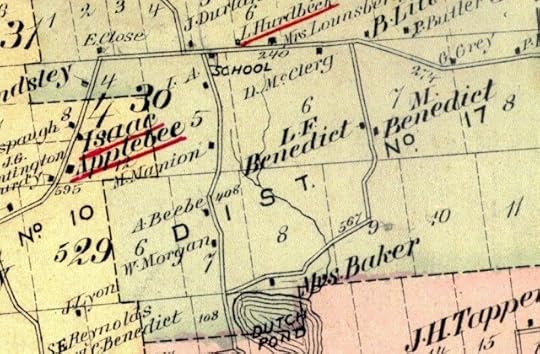
This section shows the land owned by Lawrence Hornbeck (wrongly spelled Hurdbeck) with “Mrs. Lounsbury” next to him to the east. According to the Sullivan County Directory for 1872/3, Mrs. Deborah Lounsbury farmed 74 acres. A bit more research told me that Deborah was the widow of David T. Lounsbury. I already knew that her son, Daniel, married Carrie Applebee in 1875.
Carrie was the eldest daughter of Isaac Applebee, who had moved his family from Parksville to Hurleyville in about 1861. Although Isaac listed himself as a farmer for the census, the family also ran a hotel (variously called the Applebee House, Fairlawn Farm, and Fairlawn Acres) and a store. A younger daughter, Ella Applebee, married Lawrence Hornbeck’s son, Myron, in 1883.
Census records supplied more of the story about the other plot of land my correspondent had bought. David Lounsbury owned it by the time the state census of 1855 was taken. In the federal census of 1860, his land was valued at $2000 and his personal property at $300. The value had gone up to $3600 in 1870, by which time Deborah was a widow. Daniel and Carrie Lounsbury inherited that property from her. What caused the confusion for present day descendants was that two of their children later bought some or all of the land that had been left to Constantia Hornbeck in 1897. By 1930, there were Lounsburys on both sides of the Hornbeck farm, but soon after that, following Carrie’s death, but still years before I was born, the land with the boardinghouse was sold.
And so, our mysteries all seem to be solved. The new owner now knows everything I do about his two parcels of land, the confusion over where the Lounsbury cousins lived has been cleared up, and I finally know for certain that Lawrence’s original farm was divided after his death. As both a genealogy buff and a mystery fan, I am a happy camper.
Two-part question for readers: Have you ever solved a minor mystery in real life, and did you get a kick out of the process, even if you were the only one who cared about having a solution? I’d love to have you share in the comments.

Kathy Lynn Emerson/Kaitlyn Dunnett has had sixty-four books traditionally published and has self published others. She won the Agatha Award and was an Anthony and Macavity finalist for best mystery nonfiction of 2008 for How to Write Killer Historical Mysteries and was an Agatha Award finalist in 2015 in the best mystery short story category. In 2023 she won the Lea Wait Award for “excellence and achievement” from the Maine Writers and Publishers Alliance. She was the Malice Domestic Guest of Honor in 2014. She is currently working on creating new omnibus e-book editions of her backlist titles. Her website is www.KathyLynnEmerson.com.
Where We Would Put the Body
From now until the middle of October, we’re running our annual photography contest: Where Would You Put the Body? And to join in the fun, even though members of the blog group can’t enter and win prizes, we thought we’d share a few photos of the places that we might pick.
Kate Flora: I have two favorites. One is a garden in a boat I often see on my walks to the end of the island. The other is one I spotted while going down to the dock one day.
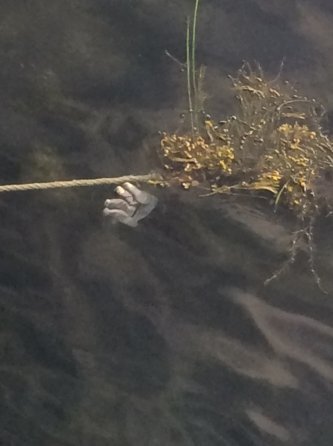

John Clark, like Kate, I have two possibilities. as the darker, more gory sibling, one of my options requires cutting the victim into pieces. The first option was inspired by a story published several years ago in a Level Best Anthology I called All Set. In it a down and out lobsterman uses a variety of the ‘Nigerian Oil’ scam to sucker a rich and greedy fellow to Washington County. Once he’s sure the fellow brought cash, he clocks him with a shovel and then dismembers him to make lobster bait. Summer folk claimed lobsters never tasted so good.

The other requires a wooded area with a large tree that has tipped sideways thanks to weakened roots. Once you’ve removed enough dirt to make a spot for the body. you use a come-along to winch the tree back to an upright position. You might need to set a couple iron posts in quick setting cement to help the tree stay upright, but the body should feed the tree nicely.
Kaitlyn Dunnett/Kathy Lynn Emerson: I’m cheating a bit because I don’t have a photo of the actual scarecrow we saw while driving in rural Maine some years ago. This one is courtesy of Wayfair (you can buy it for just under $80!).
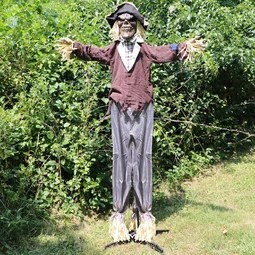
As we drove past, I actually said “what a great place to hide the body!” and then did so in my third Diana Spaudling 1888 mystery, No Mortal Reason.
Kait Carson: Where better to hide a body than in a 50-gallon drum in the middle of the woods? No one would ever know…except the wildlife!

Maggie Robinson: We told the kids it was just too darned expensive to run the hot tub all year round; our electric bill was gargantuan. In fact, we had another, somewhat more nefarious reason to shut it down. After we carefully applied each leaf one by one, they’ll never suspect what’s really under there, will they? YIMBY not NIMBY
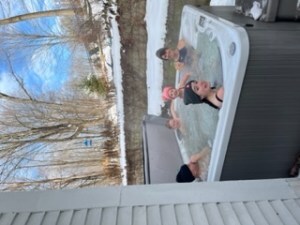

Brenda Buchanan: If you read my posts, you know I spent a lot of time outdoors at marshes and uncrowded beaches, so those are the sort of places that pop to mind when I’m ruminating about where to hide a (fictional) body. The three sites below have much to recommend them:

A marsh holds its secrets

And the natural scent of decay provides good cover

But there’s something to be said for the power of an outgoing tide.
Maureen Milliken: I knew the second I saw it that the antique horse-drawn hearse in the annex of the Belfast Historical Society & Museum would be a perfect spot to hid a body. Despite its glass windows (one cracked during a particuarly eerie moment that you’ll have to go to the museum and read about yourself), it’s unlikely anyone would look in there and notice the body for a while. It’s dark and the windows are high.
And how can you resist the irony?
If the body were dressed up to look like a Victorian corpse, even better. Anyone who just looked in would just think it was part of the exhibit.
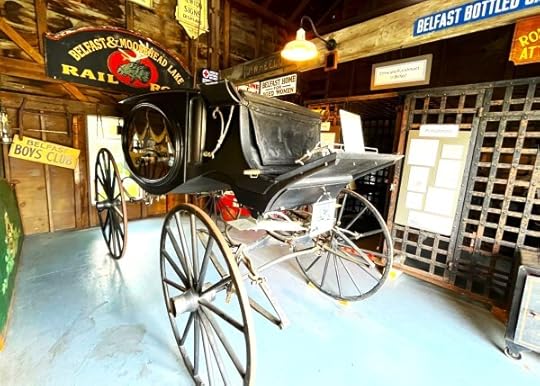
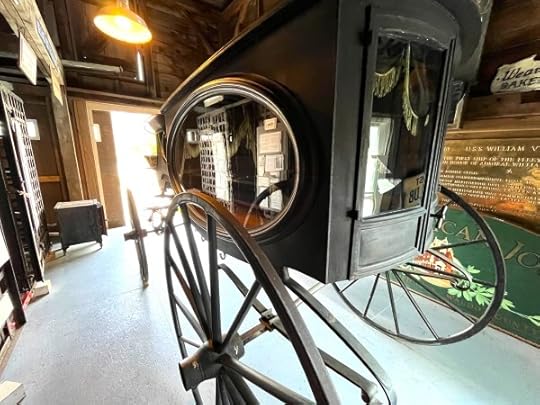 By the way, even if you aren’t stashing a body, the museum is a great place to visit. The annex has a crime in Belfast exhibit (in an old jail cell!), and the museum itself is full of exhibits and information about the very interesting history of this Midcoast city and its people. Be sure to bring $5 to donate (less for kids, but I can’t remember since I didn’t have one with me that day) if you do visit.
By the way, even if you aren’t stashing a body, the museum is a great place to visit. The annex has a crime in Belfast exhibit (in an old jail cell!), and the museum itself is full of exhibits and information about the very interesting history of this Midcoast city and its people. Be sure to bring $5 to donate (less for kids, but I can’t remember since I didn’t have one with me that day) if you do visit. 
I came upon the museum while I was researching a Belfast crime scene (not at the museum!) for the Crime & Stuff podcast I do with my sister.
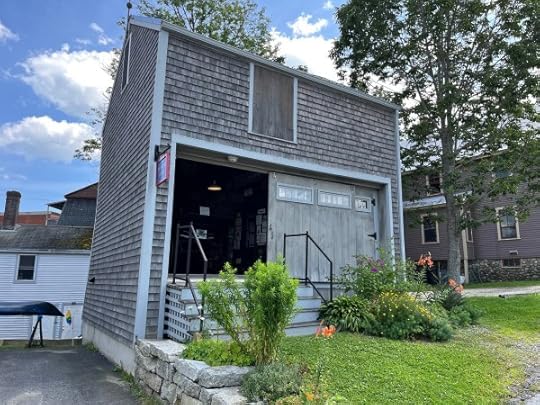

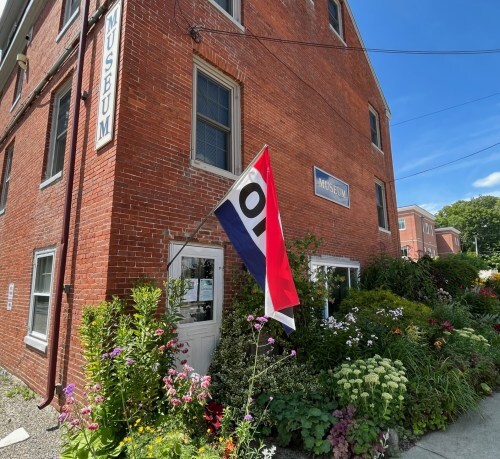
Matt Cost: What better spot to hide a body than in the shed in my backyard? It seems to be the perfect place that nobody would bother with–perhaps in a vat of lye, which takes about three hours to dissolve a human body. The drug cartels have been doing this for a long time. The process is known colloquially as making pozole, in reference to a traditional Mexican stew. In Mainely Wicked, the baddies follow this recipe (not using lye!), and hide the human bodies in their bellies. Not sure I could do that.
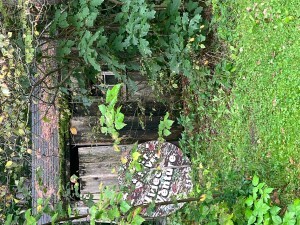
It’s Maine Crime Writers “Where Would You Put the Body?” contest – late summer/early fall edition. How do you enter? Send a photograph of your chosen spot to: WritingAboutCrime@gmail.com with “Where Would You Put the Body?” in the subject line. There will be prizes for First, Second, and Third place–books of course and other Maine goodies. You may enter no more than three photographs, each one entered separately. They must be of Maine places and you must identify the place in your submission. Photos must be the submitter’s original work. Contest will run through the middle of October.
August 30, 2023
Neurodivergent Characters vs Neurotypical Ones :: Do We Mix and Match?

So embarrassed I am.
So abashed I feel
So distraught I missed it…
Early morning, a few days ago. I was listening to Jesse Thorn’s BullsEye show on NPR; it’s one of my favorite interview shows because Thorn is a definite fan-boy and often has interesting on-air talks with people that I also admire.
A term I had never heard came up in the interview and it delighted (and saddened) me.
Neurodivergent.
I am now in apology. Because I had to look up the word. And, since blogs can be “whatever you are thinking about at that time of writing the post” I decided to do some thinking on it. So I started a crappy version of self-educating. You can stop reading now if you know all you need to know on the subject. But there are a few thoughts about character creation coming up, in case that’s interesting.
As soon as I saw the word – neurodivergent – spelled with no ‘dash’ between neuro and divergent as I was assuming it would be, I knew for sure I was a latecomer to the term. I figure when words have been around long enough to dismiss the ‘dash’ that sometimes makes a concept easier to ‘get’, they’ve been around awhile.
But – I learned it was never hyphenated. It was born with 14 letters, no dash.

In fact, an Australian sociologist Judy Singer (she’s on the autistic spectrum) coined the word as an alternative to deficit-based language – terms like disorder, affliction, malady, and disease. The term was intended to be used mainly (and has been mostly) to refer to those on the autism spectrum. Singer’s mother was autistic, her daughter has Aspergers Syndrome and she wanted to highlight strengths in the “disorder” population – things like the ability to hyperfocus, to recognize patterns, and remember facts, numbers and random information (to name a few).

NPR’s Jesse Thorn was interviewing David Bryne – the mastermind/leader of the now-defunct musical group, Talking Heads. Thorn was asking Bryne what it was like to be neurodivergent. Of course, the question tumbled into the observations and questions: aren’t we all neurodivergent because we are all different from one another? After all, we are all individuals.
That discussion is, of course, fruitless and could be endless. As often happens, well-thought-out research that, initially, has perimeters is co-opted. My research took me to Google (not the best medical research obviously but I didn’t take the time to go down to Johns Hopkins) and see what others were referring to when using the term. According to a ChatBot kind of research (I say that in a derogatory tone even though AI can be extraordinary), neurodivergence can cover a huge area: autism, ADHD, tourettes, ADD, dyslexia, dyspraxia, bipolarism, OCD, dyscalculia, and other “learning disabilities.” My (quick and scattershot) reading suggested the term could also include homophobia, racism, depression, anxiety, narcissism, god-complex, sadism, masochism, misogyny, megalomania, uncontrollable greed, and sex-addiction – the list can go on.
Which brings up the question of nature vs nurture. What are we born with and what do we learn.

What is “in our brains” (actual physical and chemical) and what do we learn/become by living in this world? Do we have to wait until our brains are studied in the MRI machine or dissected (post death in most cases) to see how “normal” our brains are? Scientists say all brains are shaped a bit differently, but with technology, signs of certain recurring physicalities that point to neurodivergences can be detected.
Of course, I asked myself if I was more neurodivergent or neurotypical?
That’s another rabbit hole that could lead to millions of never-ending tunnels.
I remember thinking during my insipid research that I wanted to be more productive, so I moved my thinking to: What about the main characters in my Dee Rommel Mystery series? Does Dee have neurodivergent tendencies – like ones in recent classics like Temperance Brennan in Bones, Adrian Monk in Monk and Abby – the forensic scientist on NCIS?

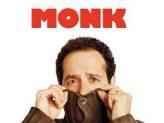
 Dee, my protagonist, has made “justice” a primary thing in her life. Once on a case, she’s compelled (would I ever call it OCD?) to bring the problem/crime to a “just” end. She’s very observant (would I ever call it hypervigilance or simultagnosia?) or do I simply perceive her ability as being a better observer than most in the “normal” population?
Dee, my protagonist, has made “justice” a primary thing in her life. Once on a case, she’s compelled (would I ever call it OCD?) to bring the problem/crime to a “just” end. She’s very observant (would I ever call it hypervigilance or simultagnosia?) or do I simply perceive her ability as being a better observer than most in the “normal” population?
In Dee’s romantic relationships she’s a deflector, she’s unable to let someone get close (would I call it philophobia or attachment disorder?) or is it a normal reaction to not being comfortable with her “new” body (does she have a dysmorphic disorder?)

**I hope you can read the “fun” I am having with all these ‘xias’ and ‘isms’ and ‘xxobias’ and syndromes. Bordering on being silly. Sorry.
Another question: IF Dee is hyper-anything, have I unconsciously surrounded her with neurotypicals?
In Neu West Writer’s magazine, I found an article by neurologist Jordan Sorokin. He wrote about BBC ‘s Sherlock Holmes (2012-2017) and the neurodiversity displayed in the main characters.
 Sorokin enjoyed how the writers embraced Holmes’ Aspberger-ness as well as his Antisocial Personality Disorder (ASPD) – the latter characterized by a disregard for social norms, frequent lies, impulsive behavior, aggressiveness and hostility, irresponsibility and risk taking, and a remorseless indifference to the feelings and rights of others. Sorokin also found neurodiversity in Watson – stating that where Sherlock obsesses over his work for the sake of solving each mystery, Watson focuses on solving each case to benefit those involved (a version of allodoxaphobia). Sorokin also points out that Watson (in this tv series) claims his limp is a consequence of a war injury, until Holmes proves to him that the limp is simply a psychosomatic manifestation connected to PTSD.
Sorokin enjoyed how the writers embraced Holmes’ Aspberger-ness as well as his Antisocial Personality Disorder (ASPD) – the latter characterized by a disregard for social norms, frequent lies, impulsive behavior, aggressiveness and hostility, irresponsibility and risk taking, and a remorseless indifference to the feelings and rights of others. Sorokin also found neurodiversity in Watson – stating that where Sherlock obsesses over his work for the sake of solving each mystery, Watson focuses on solving each case to benefit those involved (a version of allodoxaphobia). Sorokin also points out that Watson (in this tv series) claims his limp is a consequence of a war injury, until Holmes proves to him that the limp is simply a psychosomatic manifestation connected to PTSD.
Now I’ll leave this kind of breaking down of character because there’s no medical degree in my past. I’m a plain old ‘creative’ but this – for some reason – it has caught my imagination in regards to building characters.
Kristin Lamb (author of crime/mystery The Devil’s Dance and a few how-can-writers-use-social-media and also a book how AI and authors can co-exist) wrote in her blog (it’s on her author website and I just stumbled on it) about how neurodivergent characters have always been around: the nerd, the brain, the geek, the computer whiz, the conspiracy theorist, and the outcast. Now I can think of these characters (which in some instances have become cliché) as neurodivergent and can consider exploring them in new ways.

But back to David Byrne (I have been a fan for decades). He (and a partner) created a 60-minute show (parts were designed to be viewed with VR goggles in a lab in Silicon Valley) that uses theater and art to inform viewers how brains work. It’s called “Neurosociety”. Byrne makes it clear he is an ‘amateur’ and that the show is entertainment – but 35 neuroscientists (from around the world, top researchers from top universities and labs) worked on it with him. They designed experiments that are real-life scenarios such as playing with dolls, classrooms, game shows to see how individuals make choices and ‘move through the world’. Maybe you’ve seen the YouTube video on it. https://www.youtube.com/watch?v=KJMBQgY_eS0 or read about it at http://davidbyrne.com/explore/the-institute-presents-neurosociety
Bryne’s got his neurodivergent journey going on and I am happy in my (neurotypical) one right now. And I want to thank Bryne for sending me on this latest tear. I ended up going through some lyrics of Bryne’s songs and landed on “Toe Jam”. I think his neurodivergent observations in the world just inspired me for a villain I want to create in 6 DAYS.
I was asked in New York City: Do you like my clothes?
I’m talking to my tape recorder, walking down the road
But on Friday night, I’m, purified that my feet don’t touch the floor
When the rubber meets the road, in between my toes…
Lea Wait's Blog
- Lea Wait's profile
- 506 followers



